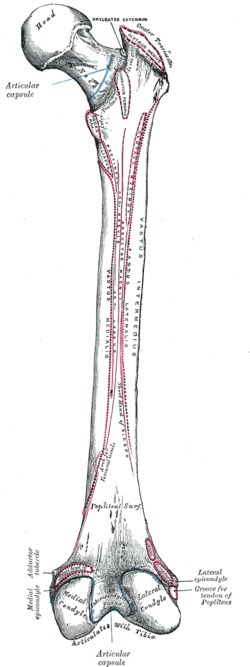Bony ridge
| Linea aspera | |
|---|---|

Right femur. Posterior surface. (Linea aspera not labeled, but region is visible. Medial lip is at left; lateral lip is at right.)
|
|
| Details | |
| Identifiers | |
| Latin | linea aspera |
| Dorlands /Elsevier |
l_10/12496065 |
| TA | A02.5.04.013 |
| FMA | 43715 |
|
Anatomical terms of bone
[]
|
|
The linea aspera (Latin: rough line) is a ridge of roughened surface on the posterior surface of the shaft of the femur, to which are attached muscles and intermuscular septum.
Its margins diverge above and below.
The linea aspera is a prominent longitudinal ridge or crest, on the middle third of the bone, presenting a medial and a lateral lip, and a narrow rough, intermediate line. It is an important insertion point for the adductors and the lateral and medial intermuscular septa that divides the thigh into three compartments. The tension generated by muscle attached to the bones is responsible for the formation of the ridges.
Above, the linea aspera is prolonged by three ridges.
Below, the linea aspera is prolonged into two ridges, enclosing between them a triangular area, the popliteal surface, upon which the popliteal artery rests.
The tension generated by muscle attached to the bones is responsible for the formation of the ridges.
A number of muscles attach to the linea aspera:
The linea aspera is perforated a little below its center by the nutrient canal, which is directed obliquely upward.
Cross-section through the middle of the thigh.
This article incorporates text in the public domain from the 20th edition of Gray's Anatomy (1918)
...
Wikipedia
